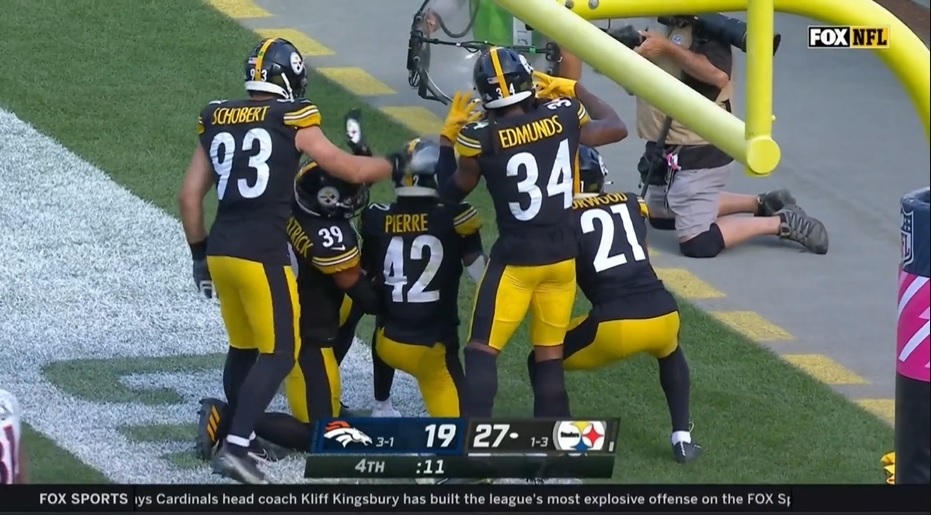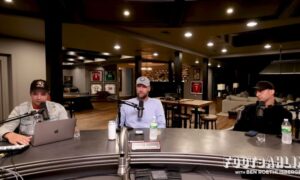For the final time of 2021, a review and recap of the Pittsburgh Steelers’ defense according to our charting. Apologize for this article coming out later than usual. With the Senior Bowl and other end-of-year happenings, I hadn’t had time to dedicate combing through our data and putting this article together.
This data is from the regular season only and don’t include the Wild Card loss.
– Excluding no-plays and kneeldowns, we are working off 1,121 defensive snaps. Here is how that number stacks up year-by-year.
2021: 1,108 snaps (65.2 per game)
2020: 992 snaps (62 per game)
2019: 1,067 snaps (66.7 per game)
2018: 1,021 snaps (63.8 per game)
2017: 979 snaps (61.2 per game)
2016: 1,040 snaps (65.0 per game)
2015: 1,102 snaps (68.9 per game)
Snaps are the most the Steelers have logged since at least 2015, but that was expected in a 17-game season (though it barely beat out 2015’s total). On a per-game basis, it’s only the third-most since ’15 behind 2015 and 2019. Of course, they all add up and no one’s body feels much better because of a “per game” basis. Snaps are snaps.
– Here’s the final personnel group info:
Nickel: 47.2% (523 snaps)
3-4: 33.8% (375 snaps)
Dime: 17.1% (189 snaps)
3-5: 1.6% (18 snaps)
Goal Line: 0.3% (3 snaps)
Nickel saw the biggest change from a year ago, its use raised from 39.2% in 2020 to 47.2% in 2021. 3-4 and dime package stayed largely the same with base 3-4 dropping by about two points while dime saw less than a one-point decrease. There were less other packages too like their 3-5 and goal line defense, which also saw slight reductions.
– The Steelers used some form of their over front on 84 snaps, or 7.5% of the total defensive snaps and 22.4% of the 3-4 snaps. The latter is actually up from 18.5% a year ago so they team used more of their over front, probably to try to gain a schematic edge with their historically bad run defense.
– Pittsburgh used “big” personnel with an extra safety in the game on 35 snaps, or 3.2% of the team’s total. That was split between 3-4 (29 snaps), nickel (5 snaps), and their 3-5 (1 snap).
– Overall, here is how the Steelers base vs sub-package splits looked this year. I’ll include 3-5 as part of that base and throw out goal line entirely since it really doesn’t fall into either of those main two buckets.
Sub-package: 64.4% (712 snaps)
Base: 35.6% (393 snaps)
Sub-package usage is up four percent from last year. Here’s how the numbers look year-by-year.
2020:
Sub: 60.1%
Base: 39.9%
2019:
Sub: 68.5%
Base: 31.3%
2018:
Sub: 68.4%
Base: 31%
2017:
Sub: 61.1%
Base: 38.8%
2016:
Sub: 70.5%
Base: 28.7%
2015:
Sub: 71.3%
Base: 27.4%
So sub-package was used about a little less than average compared to other years. While there is yearly ebb and flow and it’s partially tied to game circumstance and offensive personnel but we’ve seen base be used a bit more in recent years when comparing it to 2015 and 2016 numbers. Over the past two years, it’s been used well over one-third of the time. That correlates with strong-minded running teams in the North, the Ravens, Browns, and Bengals that will go old-school and trot out heavy packages with fullbacks and/or multiple tight end groupings.
– Here is Keith Butler/Mike Tomlin’s (really, Tomlin’s) 2021 blitz rate: 26.1%. 161 blitzes on 618 qualified dropbacks. That is down dramatically from 35.6% a year ago and a career-low since we began tracking it in 2014. Here are the yearly blitz rates:
2014: 28%
2015: 33.3%
2016: 39.7%
2017: 33.2%
2018: 44.1%
2019: 33.5%
2020: 35.6%
2021: 26.1%
The last time the blitz rate was even close to being this low was 2014, Dick LeBeau’s final year as DC.
– Here is the team’s 2021 week-by-week blitz rate:
Week 1 (Bills): 13.2%
Week 2 (Raiders): 30.0%
Week 3 (Bengals): 31.6%
Week 4 (Packers): 30.6%
Week 5 (Broncos): 31.5%
Week 6 (Seahawks): 43.8%
Week 8 (Browns): 14.7%
Week 9 (Bears): 21.6%
Week 10 (Lions): 23.1%
Week 11 (Chargers): 25%
Week 12 (Bengals): 25%
Week 13 (Ravens): 37.5%
Week 14 (Vikings): 30%
Week 15 (Titans): 29.7%
Week 16 (Chiefs): 26.7%
Week 17 (Browns): 8.7%
Week 18 (Ravens): 25%
Only twice did the Steelers blitz even two-thirds of the time. If you’re wondering, in the rematch against the Chiefs, they blitzed 35.7% of the time, an unusually high level of aggression against Patrick Mahomes, one of the top quarterbacks when facing blitzes.
– Here’s the 5+ rush number: 22.7%, 140 of 618 qualified dropbacks. Again, way down from a year ago when it sat at a Butler-high 38.9%. Here’s the yearly rates.
2015: 33.6%
2016: 27.7%
2017: 19.5%
2018: 36%
2019: 34.3%
2020: 38.9%
2021: 22.7%
The only time it’s been lower was back in 2017 when it sat at 19.5%.
– Again, here are the week-by-week numbers.
Week 1 (Bills): 13.2%
Week 2 (Raiders): 30.0%
Week 3 (Bengals): 31.6%
Week 4 (Packers): 30.6%
Week 5 (Broncos): 31.5%
Week 6 (Seahawks): 43.8%
Week 8 (Browns): 14.7%
Week 9 (Bears): 21.6%
Week 10 (Lions): 23.1%
Week 11 (Chargers): 29.2%
Week 12 (Bengals): 20.8%
Week 13 (Ravens): 31.9%
Week 14 (Vikings): 36.7%
Week 15 (Titans): 16.2%
Week 16 (Chiefs): 10%
Week 17 (Browns): 10.9%
Week 18 (Ravens): 25%
– Low numbers across the board. Not in the Week 16 game against the Chiefs, the Steelers blitzed over one-quarter of the time but sent 5+ just 10% of the time. So a lot of “safe” four-man blitzes against Mahomes to try to get home creatively while still dropping seven into coverage.
– Let’s jump into the individual numbers.
Defensive Line
Pressures
Cam Heyward: 42
Chris Wormley: 21
Isaiahh Loudermilk: 6
Montravius Adams: 4
Tyson Alualu: 3
Henry Mondeaux: 3
Carlos Davis: 1
Isaiah Buggs: 1
– Snaps per pressure. Lower the number, the better.
Alualu: 12.7
Heyward: 13.0
Wormley: 18.4
Adams: 20.3
Loudermilk: 23
Davis: 29
Mondeaux: 38.3
Buggs: 88
– Heyward finishes the year with far more pressures than last year, 42 to 32. Ditto with the more relevant per-game basis, 13.0 snaps per pressure this year compared to 15.1 in 2020.
– Montravius Adams posts a decent number for limited pass rush chances overall while these numbers show how much work Isaiahh Loudermilk has to do as a pass rusher. Just not a lot of juice there. Overall, Heyward and Wormley were the only defensive linemen able to get after the quarterback this year. Those two had more pressures individually than the rest of the d-lien combined.
– As a defense, the Steelers allowed 4.99 YPC on the ground this year. Here are the individual numbers for each player. They aren’t the end-all but add a bit of color.
Alualu: 3.35
Davis: 3.4
Loudermilk: 3.99
Adams: 4.4
Heyward: 4.65
Wormley: 5.15
Mondeaux: 5.60
Buggs: 5.65
Daniel Archibong: 8.0
Archibong, Davis, and Alualu have small sample sizes so take those with a grain of salt. Excluding those three, the d-linemen who had a YPC against higher than average when on the field were: Wormley, Buggs, and Mondeaux. Those who had a YPC lower than average when on the field were: Adams, Loudermilk, and Heyward.
The good news is Buggs is gone and Mondeaux hopefully won’t have to play as much next season, while a guy like Loudermilk will continue to improve. Loudermilk’s run defense numbers were consistently impressive all season long. It’s clear he just needs to improve his pass rush because he’s largely a run defender only now.
Linebackers
Pressures
T.J. Watt: 58
Alex Highsmith: 27
Melvin Ingram: 14
Taco Charlton: 6
Devin Bush: 5
Derrek Tuszka: 4
– Snaps per pressure. Doing this just for the EDGE guys.
Watt: 6.8
Ingram: 9.1
Highsmith: 16.1
Charlton: 16.7
Tuszka: 23
– Watt’s numbers continue to amaze with a career-high pressures despite missing two full games and parts of others. His 6.8 snaps per pressure is also off the charts and easily better what he did in 2020 (8.7). Here are those yearly per-pressure numbers:
2021: 6.8
2020: 8.7
2019: 11.1
2018: 12
2017: 9.6
Crazy.
Elsewhere, Highsmith’s pressure numbers took a dip from last year, 16.1 in 2021 after posting a 13.9 mark in 2020. It’s worth pointing out he did improve down the stretch. Over his final four games (this includes the playoff game), his pressure-rate was 12.2. Still stands to improve but there was progress at the end.
And Taco Charlton got pressure more consistently than Tuszka did.
– Coverage/drop rates:
Highsmith: 9.4%
Watt: 10.5%
Charlton: 13.0%
Tuszka: 14.8%
Ingram: 15.2%
Numbers generally clumped together and reasonable across the board. Highsmith and Watt right around ten percent while the others are between 13-15%. Highsmith might be a little lower than Watt because Watt would often drop against twin WR sets, which typically are on the offense’s right side, defense’s left, where Watt aligns.
– Watt had 685 total defensive snaps lined at LDE/LOLB or RDE/ROLB. 97.8% of those snaps came on the left side, 670 of them. Nine of his 15 on the other side came in Week 4 against the Green Bay Packers.
– Last thing. Hand-down rates for the EDGE guys:
Tuszka: 4.8%
Highsmith: 20.3%
Charlton: 35.6%
Watt: 39%
Big differences here. Tuszka rarely has his hand down, Highsmith does one-fifth of the time, while Charlton and Watt are well over one-third. And that tracks. Tuszka isn’t a big or long guy and Highsmith isn’t really either. Charlton was drafted as a 4-3 end with great length so he plays hand-down a lot and Watt is a bigger guy with good arm length. His hand-down rate has jumped up through the years.
– Target numbers:
Alex Highsmith: 3/5 2 yards 0 TDs 0 INTs
T.J. Watt: 1/7 15 yards 0 TDs 0 INTs
Robert Spillane: 14/16 143 yards 0 TDs 0 INTs
Joe Schobert: 14/24 156 yards 1 TD 0 INTs
Devin Bush: 19/28 213 yards 2 TDs 1 INT
– QB rating against:
Watt: 39.6
Highsmith: 64.6
Schobert: 91.7
Bush: 99.3
Spillane: 103.2
– Watt doesn’t cover much but according to my charting, he’s had back-to-back years with a 39.6 QB rating against. QBs have been just 2/15 for 35 yards, 1 TD and 1 INT against him the last two seasons.
The other LB numbers don’t look as bad as I thought they would but they are far from great. Spillane can tackle the catch but he can’t play the ball while Schobert and Bush allowed some big plays this year
Secondary
– Targets against:
Arthur Maulet: 12/15 180 yards 1 TD 0 INT
Ahkello Witherspoon: 7/24 122 yards 0 TD 2 INT
Tre Norwood: 20/28 226 yards 2 TD 0 INT
James Pierre: 22/34 328 yards 3 TDs 1 INT
Terrell Edmunds: 17/36 128 yards 2 TD 1 INT
Minkah Fitzpatrick: 18/37 308 yards 2 TDs 4 INTs
Joe Haden: 24/41 276 yards 3 TD 0 INT
Cam Sutton: 39/52 513 yards 3 TD 1 INT
– QB rating against:
Witherspoon: 13.5
Fitzpatrick: 55.7
Edmunds: 63.2
Haden: 103.3
Pierre: 113.4
Sutton: 116.9
Norwood: 119.1
Maulet: 138.9
– Gotta give credit to Edmunds, whose passer rating against is excellent. I don’t think his coverage is still quite as good as that number indicates but it’s improved (or stayed about the same) year-by-year:
2021: 63.2
2020: 54.2
2019: 139.6








